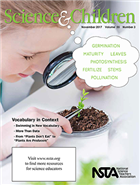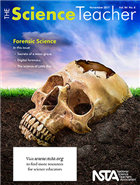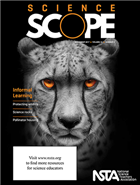Ideas and inspiration from NSTA’s November 2017 K-12 journals
By Mary Bigelow
Posted on 2017-11-09
Looking for lessons that align with NGSS? Teaching NGSS-Aligned Lessons in Science Classrooms has several examples that illustrate three-dimensional learning.
Science & Children – Vocabulary in Context
Editor’s Note: Making Sense of Science Terms : “Making sense of science terms requires selection of appropriate words, identification of strategies that help children connect with the words, and repetitive experiences over time to develop complete word knowledge. How is that accomplished? Through intervention by a teacher who uses a variety of strategies…” such as those in this month’s featured articles.
: “Making sense of science terms requires selection of appropriate words, identification of strategies that help children connect with the words, and repetitive experiences over time to develop complete word knowledge. How is that accomplished? Through intervention by a teacher who uses a variety of strategies…” such as those in this month’s featured articles.
The lessons described in the articles have a chart showing connections with the NGSS, and many include classroom materials and illustrations of student work.
- From “Plants Don’t Eat” to “Plants Are Producers” has an in-depth description of a project for young students that supports their understanding of science concepts while learning and using new vocabulary.
- Through storytelling, games, discussion, and crafts (and technology) as described in Swimming in New Vocabulary, young students experience a continuum of vocabulary activities in identification, application, and assessment.
- Vocabulary and data recording can be integral par of science notebooks. The authors of More Than Data elaborate on how notebooks can be vital and authentic components of science learning. The article includes examples of students’ notebook pages.
- A Cucurbit Ripe for Building Vocabulary describes a classroom project in which students carried out an investigation in food production (growing and harvesting cucumbers) and learned botanical vocabulary in context.
- “Adaptation” is more than a word. With the 5E lesson outlined in The Case of Polar Bears, students have hands-on and visual experiences to help them understand the concept.
- The Early Years: The Building Blocks of Language has suggestions for exposing children to new words and for developing a shared vocabulary as they explore with blocks and shapes.
- “Meet the Saurus” as students enjoy The Poetry of Science: Words, Words, Words
- Young students may have heard the word “amphibian,” but teachers can determine their misconceptions and misinformation with Formative Assessment Probes: Vocabulary in Context: What Is an Amphibian?
- Teaching Teachers: Is It Worth It? Can I Do It? showcases a professional development program that addresses the usefulness of word walls and five steps for planning and implementing them.
These monthly columns continue to provide background knowledge and classroom ideas:
- Teaching Through Trade Books: Inventions Take Center Stage
- Methods and Strategies: Time to Change
- Engineering Encounters: Chemical Reaction Vehicles
- Science 101: Why Aren’t There Magnetic Charges?
- Science 102: Haunted Face
For more on the content that provides a context for projects and strategies described in this issue, see the SciLinks topics Adaptations of Animals, Amphibians, Chemical Reactions, Dinosaurs, Food Chains, Magnetic Poles, Magnetism, Pendulums, Plant Growth, Plants as Food, Static Electricity
Continue for The Science Teacher and Science Scope
The Science Teacher – Forensic Science
 Editor’s Corner: Forensics: Solving Mysteries With Science: “Forensics activities involve careful observation, logical reasoning, and evidence-based argumentation–important skills for our students to develop….The forensic sciences–used around the world to resolve civil disputes, enforce criminal laws and government regulations, and protect public health—can provide a career pathway for our students.” (Career of the Month: Forensic Entomologist)
Editor’s Corner: Forensics: Solving Mysteries With Science: “Forensics activities involve careful observation, logical reasoning, and evidence-based argumentation–important skills for our students to develop….The forensic sciences–used around the world to resolve civil disputes, enforce criminal laws and government regulations, and protect public health—can provide a career pathway for our students.” (Career of the Month: Forensic Entomologist)
Articles in this issue that describe lessons include a helpful sidebar (“At a Glance”) documenting the big idea, essential pre-knowledge, time, and cost; many follow a 5E format. The lessons also include connections with the NGSS, and many include examples of student work and classroom materials.
- In the 5E unit Secrets of a Mass Grave, students gather, interpret, and draw conclusions from remains in a simulated mass grave.
- Gravity Can Do What? builds on students’ understanding of how energy is produced and the advantages of producing energy without fossil fuels.
- Investigate the relationship between climate change and the spread of invasive species with the resources in The Green Room: Species That Benefit From Climate Change.
- The authors of Idea Bank: Document a Crime Scene With Smartphone Apps suggest starting with a smaller “crime scene” to help students learn to analyze, photograph, and document using apps.
- The lesson in Digital Forensics also focuses on smartphones with the issues of password security, cellular metadata, digital forensics, and collecting and analyzing evidence in a simulated situation.
- The Science of Little Boy illustrates how students use modeling to construct an evidence-based explanation for how fission releases radiation and how radiation affects the human body.
- Help students learn the value of collaboration with the ideas in Working As a Team.
These monthly columns continue to provide background knowledge and classroom ideas:
- Science 2.0: Use 3D Printers to Teach Design Thinking
- Focus on Physics: Elementary Electricity in a Nutshell
- Right to the Source: The History of Fingerprinting
For more on the content that provides a context for projects and strategies described in this issue, see the SciLinks topics Anthropology, Biomolecules, Changes in Climate, Electrical Circuits, Electricity, Fingerprints, Fission, Forensic Science, Forensics, Fossil Fuels, Gravity, Insects, Invasive Species, Nuclear Reactions, Ohm’s Law, Paleontology, Radiation Effects on Humans, Skeletal System
 Science Scope – Informal Learning
Science Scope – Informal Learning
From the Editor’s Desk: Sparking the “Need to Know”: Informal learning “…which often occurs outside the confines of a classroom, can be classified as “need to know” learning. It is very powerful because it is driven by authentic questions and our own innate curiosity…. interest-driven learning can be fostered by connecting students to an online or physical community and allowing students to create products that demonstrate their learning as creators and producers of knowledge.”
The lessons described in the articles include connections with the NGSS and many include classroom resources and illustrations of student work.
- Inquiry Into Action: Ecosystems and Animals suggests pre- and post-activities to provide a learning context for a zoo visit.
- Building Bee Houses: Designing and Constructing Solitary Bee Houses for Scientific Investigations focuses on integrating the design process with a real-life study of insect pollination. The article includes photos of the student designs.
- Take a plant unit to a new dimension. Out in the Field: Learning About Plant Diversity uses a place-based learning unit as a context for students to learn about their own surroundings.
- Integrating Technology: Weather Versus Climate and Teachers’s Toolkit: How to Start a STEM Club illustrate how extra-curricular and co-curricular activities can become informal learning opportunities.
- With the investigation in Citizen Science: Where the Wildlife Are, students use camera traps to contribute to a worldwide study sponsored by the Smithsonian.
- Field trips provide students with learning experiences beyond the classroom Science For All: Planning and Preparing Your Students With Special Needs For Field Trips has ideas for making field trips valuable for all students.
These monthly columns continue to provide background knowledge and classroom ideas:
- Disequilibrium: Exploring Buoyancy and Density with Cartesian Divers
- Listserv Roundup: Technology tools for a paperless classroom
- Teacher To Teacher: Teaching With Learning Cycles and Storylines
- Scope on the Skies: Measuring the Universe
For more on the content that provides a context for projects and strategies described in this issue, see the SciLinks topics Biodiversity, Buoyancy, Cartesian Diver, Density, Ecosystems/Adaptations, Honeybees, Luminosity, Mammals, Parallax, Plant Growth, Pollination, Weather and Climate
Disclaimer: The views expressed in this blog post are those of the author(s) and do not necessarily reflect the official position of the National Science Teaching Association (NSTA).


